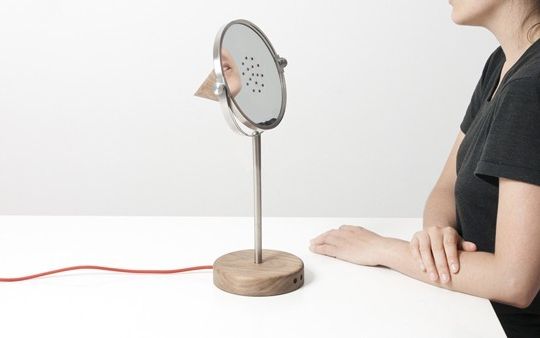Aqua Vita
In collaboration with Netherlands Metabolomics Centre
Aqua Vita
In collaboration with Netherlands Metabolomics Centre
Aqua Vita visualises the daily fluctuations of metabolites as the story of the body’s ecosystem, thus mapping our bodies ever evolving landscape and promoting individual responsibility for our health state.






Susana Cámara Leret and Mike Thompson - Aqua Vita
Susana Cámara Leret and Mike Thompson - Aqua Vita
Susana Cámara Leret and Mike Thompson - Aqua Vita
Susana Cámara Leret and Mike Thompson - Aqua Vita
Susana Cámara Leret and Mike Thompson - Aqua Vita
Susana Cámara Leret and Mike Thompson - Aqua Vita
Contrary to popular belief, urine is not waste but a biofluid rich in information, providing valuable insights into the metabolic state of an organism. This rich archive forms the basis of Aqua Vita, proposing a new understanding of the links between lifestyle and nutrition. Through the development of metabolic paintings, Aqua Vita visualises the daily fluctuations of metabolites as the story of the body’s ecosystem, thus mapping our bodies ever evolving landscape and promoting individual responsibility for our health state.
The designers collected samples of urine and saliva, underwent a Chinese constitution examination and filled out a questionnaire of Chinese medicine every day, over a six week period. These daily snapshots were fed into a timeline, visualising the dynamic changes inside the body, indicating how urine’s metabolic information changes over time.
The Netherlands Metabolomics Centre is very interested to see how the information from metabolites in their urine changes over time. Information of this kind is generally used in the form of a snapshot; in this case, the dynamic changes are made visible. This approach is in fact one of the principles of Chinese medicine, where much attention is focused on the rhythms in our body and in nature, and much value is attached to the self-healing capacity of the body. By combining the study results with Chinese medicine, Aqua Vita suggests how we may better adapt Western therapies to individuals, addressing current investigations into a future of personalised medicine, helping us better understand the links between lifestyle, nutrition and health.
In addition to the creation of the metabolic paintings, the designers have developed several objects to facilitate the collection of such data, based on their own personal experiences during the sampling phase. These objects speculate how we may interact with our own body waste and data as we move towards a future of personalised health care.
What did BAD Award mean for your practice as a bio-artist or designer?
The BAD Award brought us into contact and collaboration with the Netherlands Metabolomics Centre, through which we further linked to scientists at Leiden University and the Sino Dutch Centre for Preventive and Personalised Medicine. In this way the BAD Award has been really important for us as a studio, as we extended beyond Aqua Vita into other collaborative projects with the same team, for example in our recent and on-going The Rhythm of Life project. Perhaps the biggest lesson for us has been in learning the importance of lived experience in our work. In Aqua Vita for example, we placed ourselves as test cases to gain better critical understanding of the daily reality of self monitoring within the proposed future of personalised medicine. This approach has since become more or less central to our practice.
What are you working on/doing at the present?
We are continuing to build upon The Rhythm of Life project, which was publicly presented at Museum Boijmans van Beuningen in September 2014. More specifically we are focusing on the notion of biofeedback loops and expanding upon the hybrid research instrument created for the performance. The event last September also coincided with the official launch of Thought Collider, a critical design research studio based in Amsterdam where we are attempting to take this and other existing projects a step further by developing longer term research proposals, using design as a research medium. Most recently Mike and Arne Hendriks launched their FATBERG project, exhibited at the Matter of Life (BAD Award) exhibition at MU. Aside from this we are running a number of other projects simultaneously, including some recent collaborations with International Flavours and Fragrances, while additionally teaching at Design Academy Eindhoven and Willem de Kooning Academy.
What do you think is the importance of prizes like BAD Award for art and science? Do you experience pro’s and con’s?
The biggest challenge is the 6 month time span of the project. By the time things are in place and you start working together, you can only really scratch the surface of a topic, if that. The time period could therefore be expanded to allow for a more collaborative process. On the other hand, the Award does attempt to create better links between the arts and life sciences which is very commendable – they have a lot to learn from one another and are not as different as they are often made out to be. This is very positive as despite huge steps in the realm of DIY Biology, fundamental science remains largely distanced from artists / designers and the competition offers a chance to connect and develop meaningful work and [longer term] collaborations for both professions. However, it is important to ensure that the context of the award – art and design – promotes an open exploration so that these projects do not simply become a PR exercise for science. These collaborations should be, and are, so much more. Even if they are not fully successful in terms of their artistic, design or scientific aims, they certainly open up possibilities for future works across disciplines.